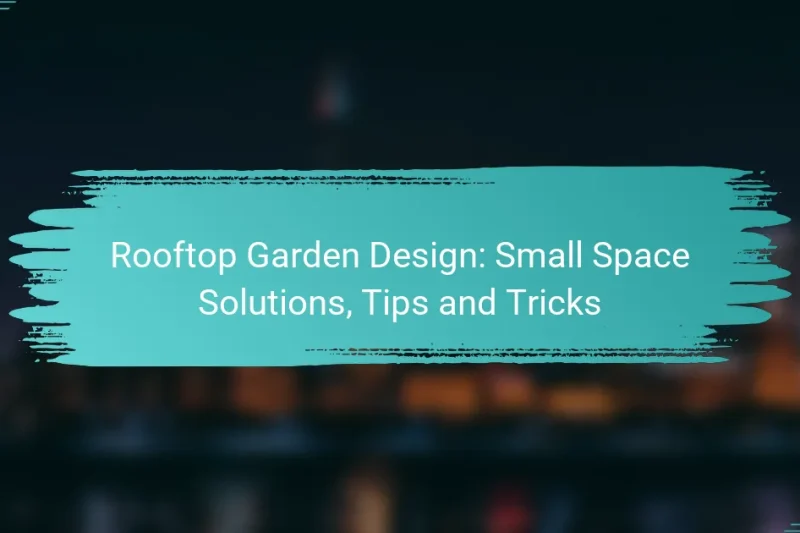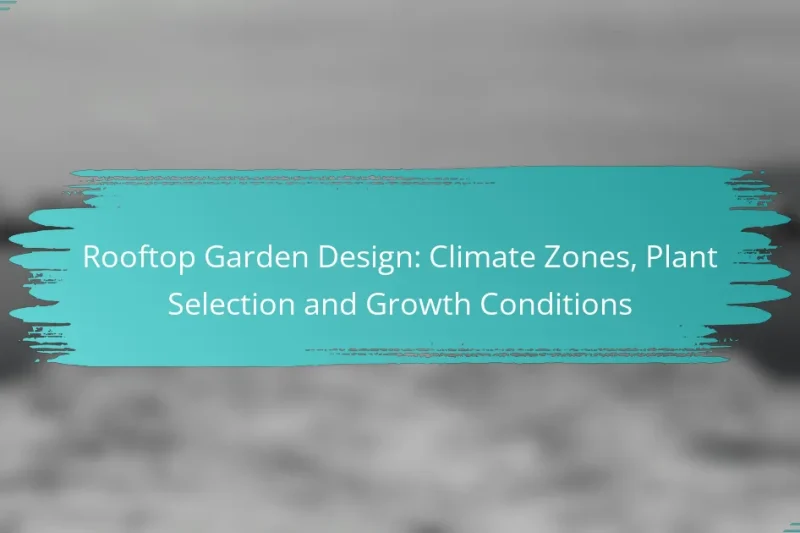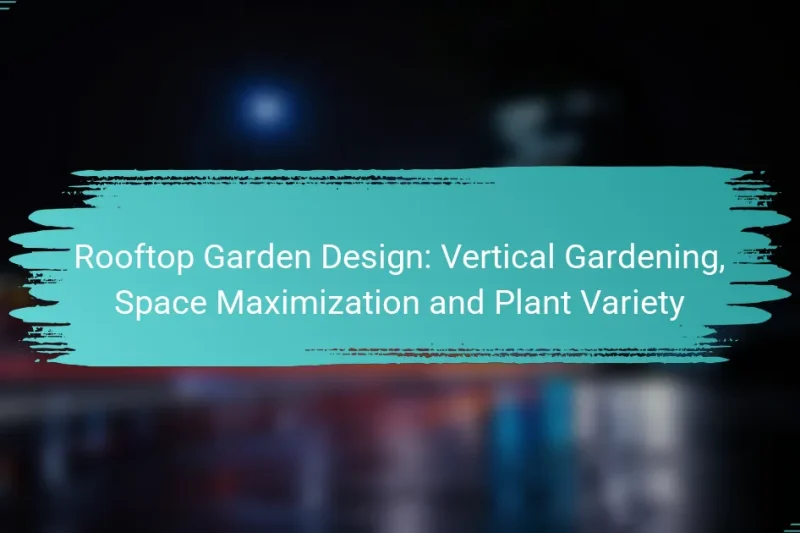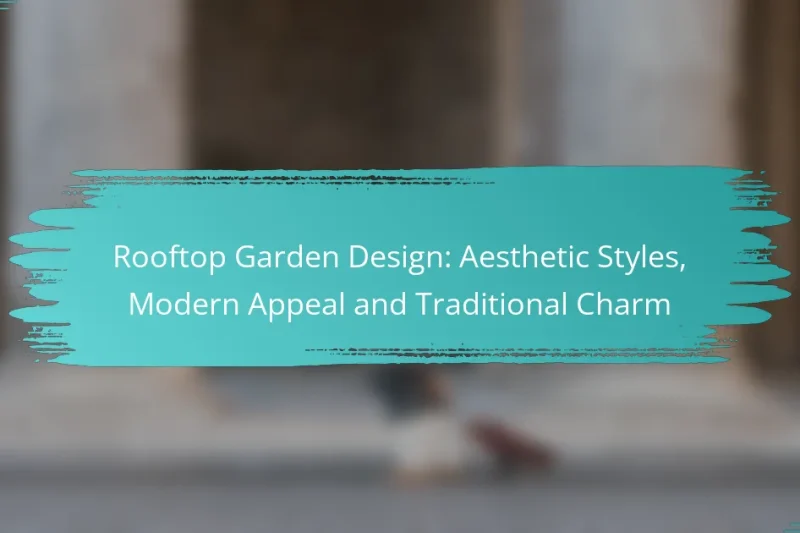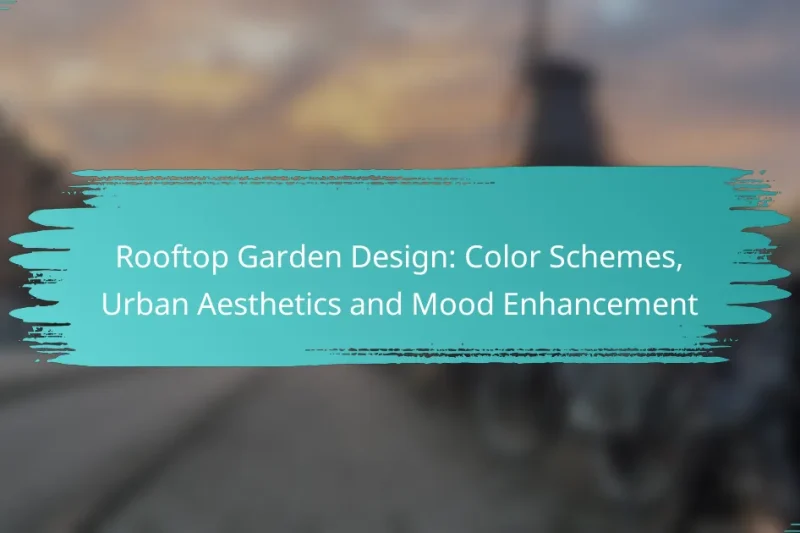Creating a rooftop garden in a small space can be both rewarding and challenging, but with … Rooftop Garden Design: Small Space Solutions, Tips and TricksRead more
Design Considerations for Rooftop Gardens
Rooftop gardens offer a unique opportunity to enhance urban spaces, but careful design considerations are essential for their success. Key factors include maximizing available space, choosing suitable plants, and ensuring proper water management, all while considering structural integrity and ease of maintenance. By focusing on these elements, rooftop gardens can become sustainable and enjoyable retreats in the heart of the city.
Rooftop Garden Design: Hardscaping Elements, Visual Impact and Functionality
Rooftop garden design integrates hardscaping elements that enhance both functionality and visual appeal, creating a harmonious … Rooftop Garden Design: Hardscaping Elements, Visual Impact and FunctionalityRead more
Rooftop Garden Design: Climate Zones, Plant Selection and Growth Conditions
Designing a successful rooftop garden requires careful consideration of climate zones, as each presents distinct challenges … Rooftop Garden Design: Climate Zones, Plant Selection and Growth ConditionsRead more
Rooftop Garden Design: Vertical Gardening, Space Maximization and Plant Variety
Designing a rooftop garden in urban environments requires careful planning to maximize limited space while creating … Rooftop Garden Design: Vertical Gardening, Space Maximization and Plant VarietyRead more
Rooftop Garden Design: Aesthetic Styles, Modern Appeal and Traditional Charm
Rooftop garden design offers a unique opportunity to blend aesthetic styles with functionality, transforming urban spaces … Rooftop Garden Design: Aesthetic Styles, Modern Appeal and Traditional CharmRead more
Rooftop Garden Design: Color Schemes, Urban Aesthetics and Mood Enhancement
Rooftop gardens offer a unique opportunity to blend nature with urban living, enhancing both aesthetics and … Rooftop Garden Design: Color Schemes, Urban Aesthetics and Mood EnhancementRead more
What are the key design considerations for rooftop gardens in urban areas?
Key design considerations for rooftop gardens in urban areas include maximizing space, selecting appropriate plants, managing water efficiently, assessing structural loads, and planning for accessibility and maintenance. These factors ensure that rooftop gardens are sustainable, functional, and enjoyable for users.
Space optimization techniques
Effective space optimization techniques are crucial for rooftop gardens, as urban rooftops often have limited areas. Vertical gardening, using wall planters or trellises, can significantly increase planting space without requiring a larger footprint. Additionally, modular planting systems allow for flexible layouts that can adapt to changing needs.
Consider using lightweight materials for planters and furniture to reduce the overall load on the rooftop. Utilizing multi-functional furniture can also help maximize usability while minimizing clutter.
Plant selection for limited sunlight
In urban environments, rooftops may receive limited sunlight due to surrounding buildings. Selecting shade-tolerant plants is essential for successful rooftop gardens in these conditions. Consider plants like ferns, hostas, and certain herbs that thrive in partial shade.
Additionally, using reflective materials can help enhance light availability. For example, placing lighter-colored surfaces around plants can help bounce sunlight, improving growth conditions even in shaded areas.
Water management solutions
Water management is a critical aspect of rooftop garden design, particularly in urban settings where water runoff can be an issue. Implementing a rainwater harvesting system can help collect and store rainwater for irrigation, reducing reliance on municipal water supplies.
Consider using drip irrigation systems to deliver water directly to plant roots, minimizing waste and ensuring efficient water use. Regular monitoring of soil moisture levels can also help prevent overwatering and promote healthy plant growth.
Structural load assessments
Before installing a rooftop garden, conducting a structural load assessment is essential to ensure the building can support the additional weight. This assessment typically involves evaluating the existing roof structure and determining the maximum load capacity.
Consulting with a structural engineer can provide insights into necessary reinforcements or modifications. Generally, a rooftop garden can add several hundred kilograms per square meter, depending on the materials and plants used.
Accessibility and maintenance planning
Planning for accessibility and maintenance is vital for the long-term success of rooftop gardens. Ensure that pathways are wide enough for easy movement and that all areas are reachable for maintenance tasks. Incorporating raised beds can also make gardening easier for individuals with mobility challenges.
Establish a maintenance schedule that includes regular watering, pruning, and pest control. Using native plants can reduce maintenance needs, as they typically require less water and are more resilient to local pests and diseases.
How do you choose the right plants for a rooftop garden?
Choosing the right plants for a rooftop garden involves considering factors like climate, sunlight, and weight limitations. Opt for plants that thrive in your local environment and can withstand the unique conditions of elevated spaces.
Native plant benefits
Native plants are well-adapted to local climates and require less maintenance, making them ideal for rooftop gardens. They typically need less water and are more resistant to pests and diseases, which can reduce the need for chemical treatments. Additionally, using native species supports local ecosystems and wildlife.
Climate-resilient species
Selecting climate-resilient species is crucial for rooftop gardens, especially in areas with extreme weather conditions. Look for plants that can tolerate heat, drought, and heavy rainfall. Succulents and certain grasses are excellent choices due to their ability to store water and withstand fluctuating temperatures.
Edible plant options
Incorporating edible plants into your rooftop garden can provide fresh produce and enhance your culinary experience. Consider growing herbs like basil and parsley, which thrive in smaller spaces, or compact vegetables such as cherry tomatoes and peppers. Ensure that the plants you choose are suitable for the available sunlight and growing conditions on your rooftop.
What are the best materials for rooftop garden construction?
The best materials for rooftop garden construction include lightweight soil alternatives, effective drainage systems, and durable waterproofing membranes. These components ensure the garden thrives while protecting the building structure from potential damage.
Lightweight soil alternatives
Using lightweight soil alternatives is crucial for rooftop gardens to minimize the load on the building. Options like expanded clay pellets, coconut coir, and lightweight potting mixes can significantly reduce weight while providing adequate drainage and aeration.
When selecting soil alternatives, consider a mix that retains moisture without becoming overly heavy. A blend of 60% lightweight aggregate and 40% organic matter is often effective for rooftop applications.
Drainage systems
Effective drainage systems are essential to prevent water accumulation, which can damage both the plants and the building. A combination of drainage mats, perforated pipes, and gravel layers can facilitate proper water flow and prevent root rot.
Ensure that the drainage system is designed to handle heavy rainfall typical in your area. Regular maintenance, such as clearing debris from drainage outlets, is necessary to maintain functionality.
Waterproofing membranes
Waterproofing membranes protect the building from moisture damage while allowing for plant growth. High-quality membranes, such as PVC or EPDM, create a barrier that prevents water from penetrating the roof structure.
When installing waterproofing membranes, ensure they are compatible with the chosen drainage system and soil alternatives. Regular inspections for wear and tear can help extend the lifespan of the waterproofing layer.
What are the environmental benefits of rooftop gardens?
Rooftop gardens provide several environmental benefits, including reducing urban heat, managing stormwater, and improving air quality. These gardens can help mitigate the negative impacts of urbanization while enhancing the overall ecosystem.
Urban heat island effect reduction
Rooftop gardens help combat the urban heat island effect by absorbing sunlight and providing shade. This can lower surrounding temperatures by several degrees, which is particularly beneficial in densely populated cities where heat can accumulate.
To maximize cooling effects, select plants that thrive in your local climate and cover as much surface area as possible. Green roofs can reduce energy costs for cooling by decreasing the need for air conditioning during hot months.
Stormwater management
Rooftop gardens play a crucial role in stormwater management by absorbing rainwater, which reduces runoff and decreases the burden on drainage systems. This can help prevent flooding and water pollution in urban areas.
Consider incorporating a variety of plants with different root depths to optimize water absorption. Additionally, using permeable materials in the garden design can further enhance water retention and filtration.
Air quality improvement
Rooftop gardens contribute to air quality improvement by filtering pollutants and producing oxygen. Plants can absorb carbon dioxide and other harmful gases, leading to cleaner air in urban environments.
To enhance air quality benefits, choose a diverse range of plants, including those known for their air-purifying properties. Regular maintenance, such as pruning and replacing dead plants, will ensure the garden remains effective in improving air quality.
What regulations should be considered for rooftop gardens?
Rooftop gardens must comply with various regulations, including local building codes, zoning laws, and safety standards. Understanding these regulations is crucial for ensuring the garden’s design and installation meet legal requirements and avoid potential fines or structural issues.
Building codes and permits
Building codes dictate the structural integrity and safety of rooftop gardens. These codes often require that the roof can support the additional weight of soil, plants, and water, which can be substantial. Before starting a project, consult local regulations to determine the specific load-bearing requirements.
Permits are typically necessary for rooftop gardens, especially if they involve structural modifications or significant landscaping. Check with your local municipality to understand the permit application process, which may include submitting detailed plans and undergoing inspections.
Common pitfalls include underestimating the weight of the garden and failing to secure the necessary permits. To avoid issues, engage with a structural engineer early in the design process and ensure all documentation is in order before beginning construction.
